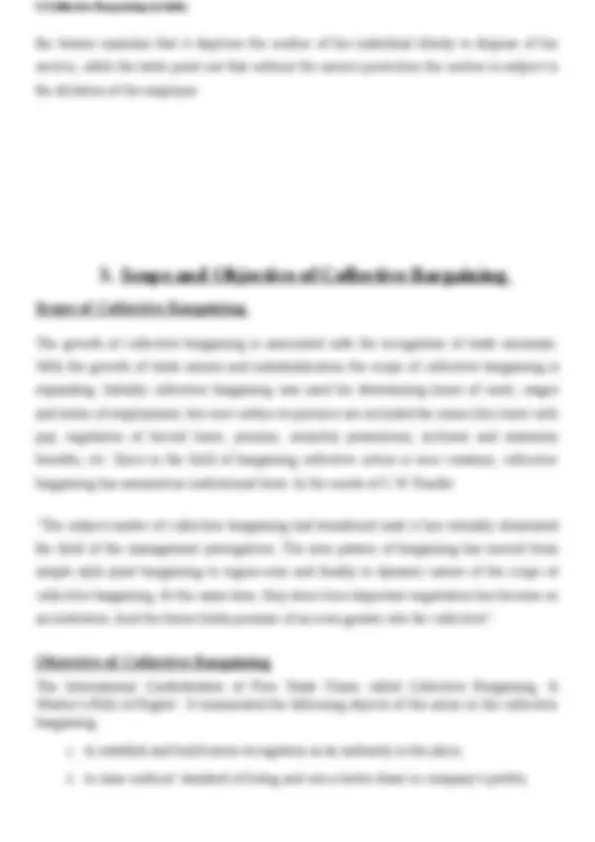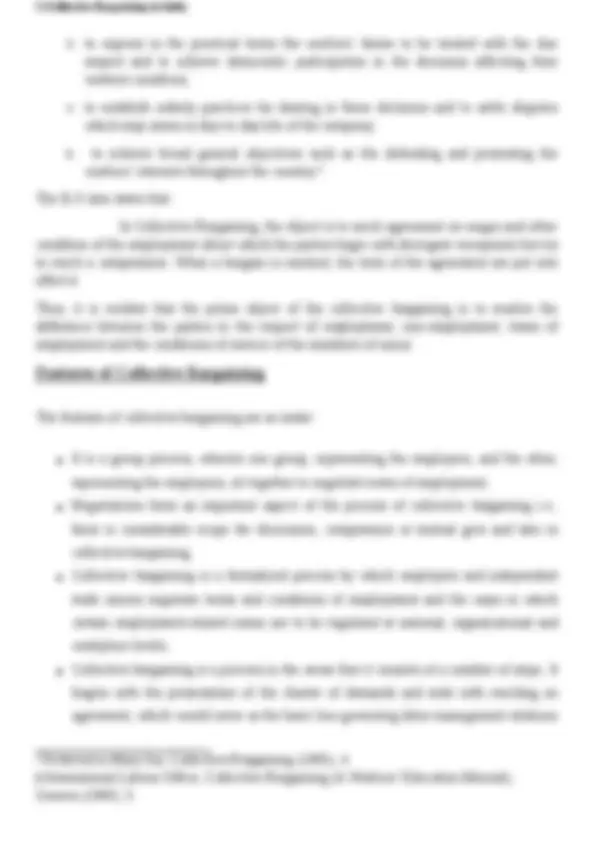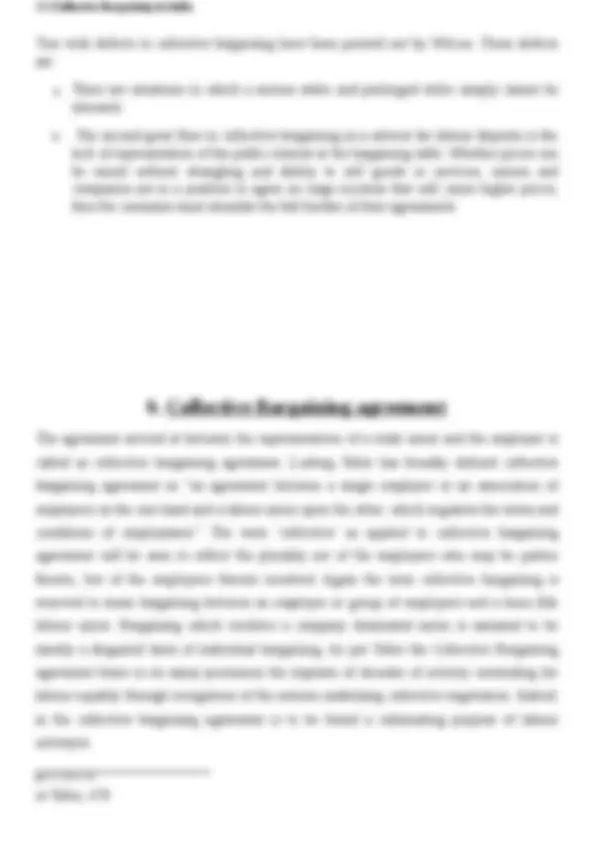
























Study with the several resources on Docsity

Earn points by helping other students or get them with a premium plan


Prepare for your exams
Study with the several resources on Docsity

Earn points to download
Earn points by helping other students or get them with a premium plan
Community
Ask the community for help and clear up your study doubts
Discover the best universities in your country according to Docsity users
Free resources
Download our free guides on studying techniques, anxiety management strategies, and thesis advice from Docsity tutors
it is my research on the topic of collective bargaining in India
Typology: Study Guides, Projects, Research
1 / 30

This page cannot be seen from the preview
Don't miss anything!























SUBMITTED BY : Himanshu Chaudhary
ENROLLMENT NO: 372209
EXAM ROLL NO: 14137LA
FACULTY OF LAW, BHU, VARANASI
It was a great pleasure for me to prepare a project in one of the most important topic of the Labour Law while dealing with the topic “ Collective Bargaining in India.”
I came across many points related to it and tried my best to express it in this project. This project is mainly focus on Meaning, definition, concept of Collective Bargaining, Advantage and disadvantage of collective bargaining and its application in India. I have made special endeavors to present the subject matter in the simple, systematic and lucid manner.
I am grateful to all those who helped me in writing the project, without their help, it was not possible to complete this project. I am also grateful to Dr. R. K. Murli for giving me to prepare and present this topic.
Thank you Himanshu Chaudhary
Introduction……………………………………………………………………… …………………… 3 – 4
The conflict between the management and the employee is inherent in an industrial society. One argues for more investment and profits while the other argues for better standard of living. These two conflicting interests can be adjusted temporarily through the principle of "give and take" 1 ; the principle of give and take has been infused in the principle of collective bargaining. The phrase "collective bargaining" was coined by British labor reformers Sidney and Beatrice Webb of Great Britain which was the “home of collective bargaining” in the 1890’s 2
. The idea of collective bargaining emerged as a result of industrial conflict and growth of trade union movement and was first given currency in the United States by Samuel Crompers. In India the first collective bargaining agreement was conducted in 1920 at the instance of Mahatma Gandhi to regulate labour management relation between a group of employers and their workers in the textile industry in Ahmadabad 3. Advocates of collective bargaining in the early decades of the twentieth century thought it essential for three reasons. First and foremost, a system of peaceful and routine bargaining would eliminate industrial strife and violence. Second, collective bargaining stood for "industrial democracy," and finally, collective bargaining promised to make capitalism work. In any industrial establishment the friction between employer and the workmen is inevitable. There are demands by the workmen and if those demands are resisted by the employer, industrial dispute arises resulting in industrial tension and disturbing the peace and harmony in the industry. Collective Bargaining is one of the methods wherein the employer and the employees can settle their disputes. There was always a need of a legislation which could ensure industrial justice pre-empt the industrial tensions and provide the mechanics of dispute resolution. When Industrial Disputes Act, 1947 was passed in India, it was passed to provide machinery and form for the investigation of industrial disputes and for the settlement thereof and for the purposes analogous and incidental thereto. As is evident from the Act itself that it is piece of legislation which mainly provides for investigation and settlement of Industrial disputes. The system of Collective Bargaining as a method of settlement of industrial disputes has been adopted in the industrially advanced countries like the United States of America and
1 Otto Kahn-Freund, Laboar aad the Law, L mdon, Stevens & Sons, (1977\ .). 49 2 Webb, Sydney and Beatrice, Industrial Democracy,1902,p. 3 Report of Royal Commission on Labour in India, 1931; p. 336-
United Kingdom and has also recently been adopted in some Asian and African countries. India, which has compulsory adjudication system, has also accepted in principle the system of collective bargaining but has hardly taken any steps, legislative or otherwise, to apply it in practice.
In the words of Justice Desai the emergence of the concept of welfare state implies an end to exploitation of workmen and as a corollary to that collective bargaining came into its own and lest the conflicting interests of the workmen and the employer disturb the industrial peace and harmony, a machinery for adjustment of such conflicting interests became the need of the time. The Act therefore was enacted to provide machinery and Forum for adjustment of such conflicting and seemingly irreconcilable interests without disturbing the peace and harmony in the industry assuring the industrial growth which was the prerequisite of for a welfare state. Collective bargaining is one of the methods wherein the employer and the employees can settle their disputes. This method of settling disputes was adopted with the emergence and stabilization of the trade union Government. Before the adoption of the collective bargaining the labour was at a great disadvantage in obtaining reasonable terms for contract of service from its employer. With the development of the trade unions in the country and the collective bargaining becoming the rule it was equally found by the employers that instead of dealing with individual workmen it is convenient and necessary to deal with the representatives of the workmen not only for the making or modification contracts but also in the matter of taking disciplinary action against the workmen and regarding other disputes. So, collective bargaining has come to stay having regard to modern conditions of the society where capital and labour have organized themselves into groups for the purpose of fighting and settling their disputes.
There is no precise definition of “Collective bargaining”. In fact keeping in view the change in the society with its fast changing social norms the scope and content of collective also varies from country to country. Nevertheless, Collective bargaining has been defined by different experts in different ways. It is treated as a method by which problem of wages and conditions of employment are resolved peacefully and voluntarily between labour and management. 4
According to K. Alexander
4 I.L., Labour Law and Labour Relations, N.M. Tripathi (Pvt) Ltd., Bombay, (1968), P.29:
Collective bargaining as a technique of the rise of a new class is quite different, from the desire to displace or "abolish" the "old ruling class", to gain equal rights as a class, to acquire an exclusive jurisdiction in that sphere where the most immediate interests, both material and spiritual, are determined. And a shared jurisdiction with the older class or classes in all other spheres."^5 The best justification for collective bargaining is that it is a system based on bipartite agreements, as such superior to any agreement involving third party intervention in matters which essentially concern employers and workers. 6
In Encyclopedia of Social Sciences, collective Bargaining has been defined a process of discussion and negotiations between two parties, one or both of whom is a group of persons acting in concert. The resulting bargain is an understanding as to terms and conditions under which a continuing service is to be performed. More especially, collective bargaining is the procedure by which an employer or employers and a group of employees agree upon the conditions of work.
In the words of John T Dunlop , “Collective Bargaining is:
In sum collective bargaining, is labor relations, procedure whereby an employer or employers agree to discuss the conditions of work by bargaining with representatives of the employees, usually a labor union. Its purpose may be either a discussion of the terms and conditions of employment (wages, work hours, job safety, or job security) or a consideration of the collective relations between both sides (the right to organize workers, recognition of a union, or a guarantee of no reprisals against the workers if a strike has occurred). The merits of collective bargaining have been argued by both opponents and proponents of the process; 5 See Eugene V. Schneider, Industrial Sociology, London, Mc GrawHill, (1971), P. 344. 6 [Report of National Commission on Labour, p.325]
the former maintain that it deprives the worker of his individual liberty to dispose of his service, while the latter point out that without the union's protection the worker is subject to the dictation of the employer.
The growth of collective bargaining is associated with the recognition of trade unionism. With the growth of trade unions and industrialization the scope of collective bargaining is expanding. Initially collective bargaining was used for determining hours of work, wages and terms of employment, but now within its purview are included the issues like leave with pay, regulation of forced leave, pension, seniority promotions, sickness and maternity benefits, etc. Since in the field of bargaining collective action is now common, collective bargaining has assumed an institutional form. In the words of C.W. Randle:
“The subject matter of collective bargaining had broadened until it has virtually eliminated the field of the management prerogatives. The area pattern of bargaining has moved from simple style plant bargaining to region-wise and finally to dynamic nature of the scope of collective bargaining. At the same time, they show how important negotiation has become as an institution. And the future holds promise of an even greater role for collective”.
The International Confederation of Free Trade Union called Collective Bargaining ‘A Worker’s Bills of Rights’. It enumerated the following objects of the union in the collective bargaining:
over a period of time in an enterprise. Moreover, it is flexible process and not fixed or static. Mutual trust and understanding serve as the by products of harmonious relations between the two parties; ▲ It a bipartite process. This means there are always two parties involved in the process of collective bargaining. The negotiations generally take place between the employees and the management. It is a form of participation; ▲ Collective bargaining is a complementary process i.e. each party needs something that the other party has; labor can increase productivity and management can pay better for their efforts; ▲ Collective bargaining tends to improve the relations between workers and the union on the one hand and the employer on the other; ▲ Collective Bargaining is continuous process. It enables industrial democracy to be effective. It uses cooperation and consensus for settling disputes rather than conflict and confrontation; ▲ Collective bargaining takes into account day to day changes, policies, potentialities, capacities and interests; ▲ It is a political activity frequently undertaken by professional negotiators.
Collective bargaining has two pronged concerns:
In fact, it has been recognised as a method of determining the wage rates and other terms and conditions of employment and of regulating the relations between the management and organized labour. Collective bargaining includes provisions with respect to hiring, lay-offs, promotions, transfers, work scheduling, work assignment, wages, welfare programmes, retirement benefits, discipline, etc.
In order to achieve collective bargaining, it is essential to ensure that the denial of such freedom negates collective bargaining. In this respect, it is significance to note that the International Labour Organization adopted the ‘Convention No. 87 concerning freedom of association and protection of the right to organize’ which seeks to provide for freedom of association. India has, however, not formally ratified this convention perhaps due to administrative and constitutional problems. However, Article 19(1) (c) of the constitution of India guarantees ‘the right to form association or unions.’ Earlier the Trade Unions Act, 1926 impliedly concedes the freedom of association by conferring certain rights, duties and immunities upon members of registered trade unions. However, there is need to ratify ILO Convention.
For the success of collective bargaining, it is also essential that there should be strong, independent, democratic and well organized trade unions. Unorganized labour is the hurdle in its success. In India, however, the unions are generally weak. Rivalry on the basis of caste, creed, and religion is another characteristics of Indian trade unions which come in the way of successful collective bargaining. Further, division on the basis of political ideologies further retards the growth unions. Moreover, most of the workers are illiterate. Lastly, the financial position of trade unions is weak and some of them are even unable to maintain a proper office.
The management should give recognition to the trade union for participating in the collective bargaining process. In case there is more than one union, selection could be done through verification of membership by a government agency giving representation to all the major unions through joint consultations. Thus, the bargaining agent of the workers should be properly identified before initiating any action.
Whether the dealings are confined to enterprise level, industry level, regional or national level should be decided as the contents, scope and enforcement agencies differ in each case.
It would be better to have a clear understanding of what are the issues to be covered under bargaining. Many a time, bargaining is restricted to wage and working conditions related issues but it would be advantageous for both the management and union to cover as many issues as possible to prevent further friction and disputes. Therefore, all the important and interrelated issues are to be taken for consideration.
Two vital defects in collective bargaining have been pointed out by Wilcox. These defects are:
a. There are situations in which a serious strike and prolonged strike simply cannot be tolerated. b. The second great flaw in collective bargaining as a solvent for labour disputes is the lack of representation of the public interest at the bargaining table. Whether prices can be raised without strangling and ability to sell goods or services, unions and companies are in a position to agree on wage increase that will cause higher prices, then the consumer must shoulder the full burden of their agreement 9.
The agreement arrived at between the representatives of a trade union and the employer is called as collective bargaining agreement. Ludwig Teller has broadly defined collective bargaining agreement as “an agreement between a single employer or an association of employers on the one hand and a labour union upon the other, which regulates the terms and conditions of employment.” The term ‘collective’ as applied to collective bargaining agreement will be seen to reflect the plurality not of the employers who may be parties thereto, but of the employees therein involved. Again the term collective bargaining is reserved to mean bargaining between an employer or group of employers and a bona fide labour union. Bargaining which involves a company dominated union is assumed to be merely a disguised form of individual bargaining. As per Teller the Collective Bargaining agreement bears in its many provisions the imprints of decades of activity contending for labour equality through recognition of the notions underlying collective negotiation. Indeed, in the collective bargaining agreement is to be found a culminating purpose of labour activity 10.
9 [ALJ, (1965) p.39] 10 Teller, 476
Collective agreements may be written or unwritten. Whatever be the form of agreements these may be looked upon as legislative acts setting forth the rules governing employment relationship for a specified period of time. However, these laws are private in nature. Despite many of the laws passed by the legislature, these agreements are of greater importance to the workers in majority of cases. The economic strength of the parties is supposed to be the main sanction behind a collective agreement. If a party under the agreement does not agree to abide by and fulfill the commitments, the other party in order to meet its obligations can force him by resorting to economic pressures to do so.
Validity of Collective Bargaining Agreements
The collective bargaining agreements may have been made subjects of litigation regarding their validity, enforceability and interpretation. The usual case involves where an employee files a suit in pursuant to the agreement to recover damages or assets his seniority rights guaranteed to him in the agreement. But there are other ways also whereby the problem is raised. For example, a suit may be filed by the labour organization, an employer or employer’s association for specific performance or to claim damages or to seek the enforcement of an arbitration clause stipulated in the agreement. If there is an alleged violation of the agreement it is sometimes sought to enjoin a strike or lock-out called for the purpose or sometimes the labour organization is the plaintiff seeking to enjoin a lock-out in breach of the agreement or failure to hire union employees etc. Where the legality of the agreement is designed to be destroyed, the validity of collective bargaining agreement is also tested in these proceedings. As for example, to secure a closed shop or to regulate an entire industry by prescribing rules governing competition etc.
Duration of Collective Bargaining Agreements
The durations of collective bargaining agreements vary widely. Unions generally favour shorter contracts, while managements favour longer ones. In the United States many of the contracts are for a period of one to three or more years, with options to renew. In the United Kingdom, “open end” contracts, which can be negotiated on notice at any time, are the rule. In the Scandinavian countries, one year contracts with renewal clauses are usual.
The position in India is not clear. A study of 114 contracts in 1961 by the Employers Federation of India showed that a majority of them were for one to five years, with a strong
The signing of the contract makes a great impression on the rank and file of the union. “ Its formal language is the mark of its significance and…a guarantee that the management will carry out its pledged word. It strengthens the position of the union in the eyes of the members, and it provides basis for a continuing and dignified relationship between the management and the employers”. 12
Enforcement of Collective Bargaining Agreements
The enforcement of bargaining contracts depends in some countries on the good faith of the parties and in others, on that, plus the law. In the United Kingdom, such contracts are called “gentlemen’s agreements”. To enforce them in a court of law, workers must rely on their individual contracts with their employer, which may in some cases incorporate the larger agreement. In a great many countries of Europe, Latin America and Asia, the effects of the contract are regulated by special legislation. They can then be enforced in a court of law, either by the union or by the individual worker, through an action for damages for breach of
12 Mary Sur, Supra Note 1 at 107
contract. Scandinavian countries, Germany, Ireland and some Latin American countries have established special courts to enforce the contracts on the grounds that procedure in ordinary courts is long and costly, that delay may result in a strike and to secure a quick remedy. The actions here must usually be brought by the unions; but in some cases individuals may be allowed to start proceedings. 13
In India, the collective bargaining agreements can be enforced under section 18 of the Industrial Disputes Act, 1947, as a settlement arrived at between the workers and the employers. The appropriate government may refer the dispute over a breach of contract to a labour court or to an industrial tribunal.
Collective Bargaining as a method of industrial disputes is comparatively a recent development. However, it has been debated ever since the days of the Royal Commission of Labour. The planners paid considerable attention to the adoption of the system of collective bargaining to solve labour disputes in India. 13 ILO, Collective Bargaining 71-
These are most important types of collective agreements because they represent a dynamic relationship that is evolving in establishment concerned without any pressure from outside. The bipartite agreements are drawn up in voluntary negotiation between management and union. Usually the agreement reached by the bipartite voluntarily has the same binding force as settlement reached in conciliation proceedings. The implementations of these types of agreements are also not a problem because both the parties feel confident of their ability to reach the agreement.
It is tripartite in nature because usually it is reached by conciliation, i.e. it arises out of dispute referred to the appropriate labour department and the conciliation officer plays an important role in bringing about conciliation of the differing viewpoints of the parties. And if during the process of conciliation, the conciliation officer feels that there is possibility of reaching a settlement, he withdraws himself from the scene. Then the parties are to finalise the terms of the agreement and should report back to conciliation officer within a specified time. But the forms of settlement are more limited in nature than bipartite voluntary agreements, because they strictly relate to the issues referred to the conciliation officer.
Here the negotiation takes place between the parties when the dispute is actually pending before one of the compulsory ad judicatory authorities and the agreement is incorporated to the authorities, award. Thus though the agreement is reached voluntarily between the parties, it becomes part of the binding award pronounced by an authority constituted for the purpose.
The idea of national or industry-wide agreements and that too on a particular pattern may appear to be a more ideal system to active industrial relation through collective bargaining, but the experience of various countries shows that it is not possible to be dogmatic about the ideal type of collective bargaining, because it largely depends upon the background, traditions and local factors of a particular region or country.
Collective Bargaining machinery essentially is a reflection of a particular social and political climate. The history of the trade union movement shows that union are affiliated to one or the other political parties. As a result most of the trade unions are controlled by outsiders. Critic says that the presence of outsiders is one of the important reasons for the failure of collective bargaining in India. 18
The Trade Unions Act, 1926, permits outsiders to be the office bearers of a union to the extent of half the total number of office bearers. 19 So, it permits one to be the leader of the union who does not actually work in the industry. Sometimes a dismissed employee working as a union leader may create difficulties in the relationship between the union and the employer. 20 Nevertheless, experience shows that outsiders who have little knowledge of the background of labour problems, history of labour movement, fundamentals of trade unionism and the technique of the industry and with even little general education assume the charge of labour union and become the self-appointed custodian of the welfare of workers.
18 S.N. Dhyani, Trade Union and the right to strike, S. Chand & Co. (Pvt.) Ltd, New Delhi, PP. 374-380. 19 See Section 22 of the Trade Unions Act, 1926, 20 See Report of the National Commission on Labour, (1969), P. 288